




 |
|
|||||||||||||||||||||
 |
|
|
|
|
|
|
|
|
|
|||||||||||||
|
|
|
|
|
|
||||||||||||||||||
|
|
|
|
|
|
|
|
|
|
||||||||||||||
|
|
|
|
|
|
||||||||||||||||||
|
|
|
|
|
|
|
|
|
|
||||||||||||||
|
|
|
|
|
|
||||||||||||||||||
|
|
|
|
|
|
|
 |
|
|||||||||||||||
 |
 |
|
||||||||||||||||||||
|
|
|
|
||||||||||||||||||||
|
|
|
|
|
|
|
|
|
|
|
|
|
|
|
|
|
|
|
|
|
|
|
|
| Mouth Markings of Estrildid Finch Chicks | ||||||
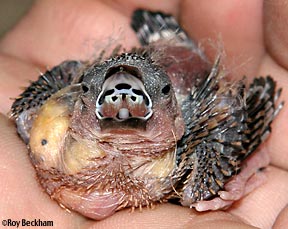 |
||||||
| • What are Mouth Markings?
• Zebra Finches • Australian Grassfinches • Mannikins - Asia/Africa • Other Finches |
||||||
|
What are Mouth Markings? As aviculturists, being able to identify a chick by its mouth markings can be an asset. I often use the mouth markings to identify chicks in mixed clutches that have been fostered. They can also be used to identify tossed chicks in mixed aviaries, or to identify a nest of surprise chicks that you're unsure of their parentage. Another thing to be aware of is the effect of mutations on the mouth markings and the attention the parents may or may not give that chick. Often, the dilution seen in the plumage is also seen in the mouth color and the markings. White or albino birds often lack any color at all in their mouth markings and this can sometimes lead to chicks that lag behind or are not fed at all if mixed with chicks with normal mouth markings. |
| Zebra Finches - (Taeniopygia guttata castanotis) The mouth markings of the Zebra finch have a classic 'domino' pattern with a chevron at the top, twin marks on the tongue, and tear-shaped marks on the lower mandible. Notice the decrease in color and contrast in the mouth markings the lighter the feather color of the bird becomes. |
|||||||||||||
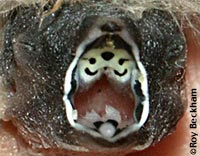 |
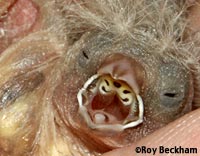 |
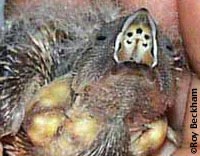 |
|||||||||||
| Normal Gray Zebra | Fawn Zebra | Lightback Gray Zebra | |||||||||||
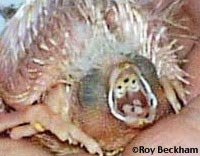 |
 |
||||||||||||
| Fawn Cheek Zebra | Chestnut Flanked White (CFW) Zebra - Regular CFW (left) and Continental variety (right). The regular variety is an exception to the rule. It is a mostly white bird, but the mouth markings are not changed that dramatically from the normal coloration. The red-eyed, pink skin Continental CFW is devoid of any coloration in it mouth markings. This is very similar to the all white mutation. (Read about the different CFW varieties and how they relate to each other and Lightbacks). | ||||||||||||
| Timor Zebra Finch - (Taeniopygia guttata guttata) | |||||||||||||
 |
 |
||||||||||||
| Timor Zebra Finch | Australian Zebra (T.g. castanotis) x Timor Zebra Finch (T.g. guttata) Hybrid. | ||||||||||||
| Australian x Timor Zebra Finch Hybrid Experiment (click to see my results) | |||||||||||||
| Australian Finches | |||||||||||||
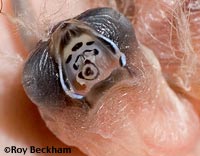 |
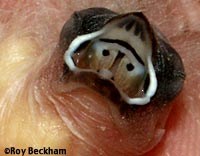 |
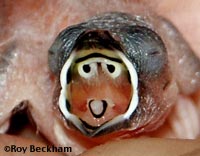 |
|||||||||||
| Owl Finch (Bicheno) - Taeniopygia bichenovii - Being closely related to Zebra finches, the Owl's markings are similar to the Zebra's, but are elongated in shape. | Star finch - Neochimia ruficauda - The Star's top three markings of the domino have joined to form a near Horseshoe that is reminiscent of the mannikins. | Plumhead finch - Aidemosyne modesta - The Plumhead's pattern is similar to the Star's and the plumage of the adult is more similar to mannikins than the Star. | |||||||||||
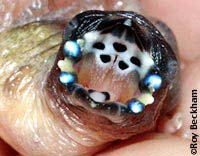 |
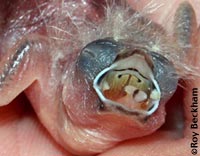 |
 |
|||||||||||
| Gouldian Finch - Chloebia gouldiae - The pearlescent nodules in the corner of the mouth reflect light so the gaping mouth is easy to see in the dark nest. Parrot finches are the only other estrildids to have these. | Heck's Shafttail - Poephila acuticauda hecki - A modified domino pattern that shows the migration of the dots towards the pattern seen in Lonchuras. Similarities to Star and Plumhead finch. | Masked Grassfinch - Poephila personata - While the domino pattern is typical of the Australians, the lack of a closer relationship to the Shafttail is surprising. However, these species are often seen together in the wild. Nest differentiation? | |||||||||||
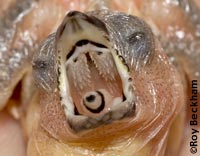 |
 |
||||||||||||
| Painted Firetail - Emblema Picta - A merged chevron like the Shafttail. Interesting little bumps along the mouth flanges. Could these be a primitive version of Gouldian nodes? | Diamond Firetail - Emblema guttata - Similar convergence of upper palate markings to Painted Firetail. Interesting large dots on mouth flange giving indication of development towards Gouldian/parrot finch . | ||||||||||||
| Munias and Mannikins - The Lonchura | |||||||||||||
 |
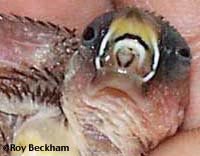 |
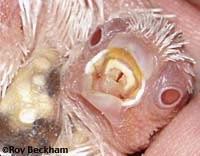 |
|||||||||||
| Society Finch (Bangalese) - Lonchura striata domestica - A chocolate self that is close to the wild state the White-rump mannikin. The single horseshoe is seen in Asian mannikins. | Society Finch - L. striata domestica - Fawn self mutation. Notice the dilution of the yellow palate along with the skin pigments. | Society Finch - L. striata domestica - Albino mutation. Notice the absence of all pigment in the mouth as well as the eyes. | |||||||||||
 |
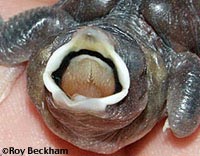 |
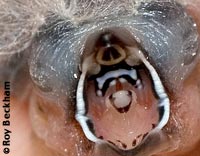 |
|||||||||||
| Rufous-Backed Mannikin - Lonchura nigriceps - A double-horseshoe pattern is seen in this African mannikin. The tongue moves rapidly back and forth along the pattern. | African Silverbill - Lonchura cantans - A single horseshoe pattern that is elongated to the extremes of the mouth. Dark color and fleshy flanges are similar to the Red Headed finch (below) | Pearl Headed Silverbill - Lonchura griseicapilla - A fairly unusual palate marking especially for a Lonchura species. The chick also has a lot of fuzz which is unusual for this genus. | |||||||||||
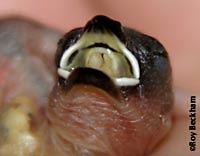 |
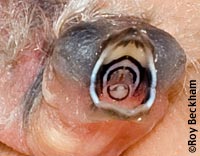 |
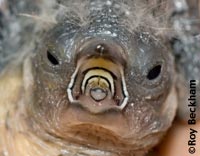 |
|||||||||||
| Madagascar Mannikin - Lonchura nana - Pattern looks like an intermediate form from African Silverbills to palate only markings of other Lonchura. | Magpie Mannikin - Lonchura fringilloides - A double horseshoe pattern much like the Rufous-back. Doubles are seen more in African mannikins. | Black & White Mannikin - Lonchura bicolor - Very similar to close relative Rufous-back, but note the lower horseshoe pattern differences. | |||||||||||
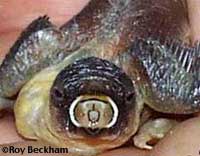 |
 |
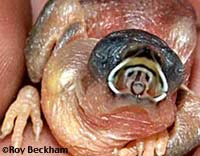 |
|||||||||||
| Spice Finch - Lonchura punctulata - The horseshoe pattern is flattened. The gape is also very oval in shape | Grand Mannikin - Lonchura grandis - Typical of the Asian mannikins with a single horseshoe pattern and typical tongue patter as well. Note the large beak even on the young nestling. | Tricolor Nun - Lonchura malaca - The two dots below the horseshoe pattern is reminiscent of the domino pattern seen in Australian species, like the Plumhead. | |||||||||||
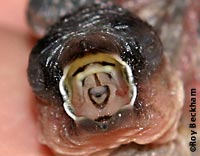 |
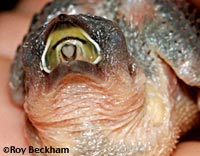 |
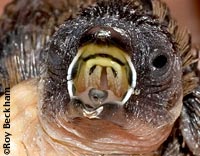 |
|||||||||||
| Gray-Crown Mannikin - Lonchura nevermanni - Typical horseshoe pattern that appears as an intermediate form from Tricolor Nun to Chestnut Breasted. Note the elongated dots below the horseshoe pattern. | Chestnut-Breasted Mannikin - Lonchura Castaneothorax - The single 'horseshoe' pattern in this mannikin from Australia is typical of Asian mannikins. It is more pointed in the center than most Asian mannikins. | Chestnut-Breasted Mannikin Sharpii- Lonchura Castaneothorax sharpii - This subspecies of the nominate form (left) not surprisingly has very similar markings. Perhaps the lower markings are a bit more pronounced than the nominate. | |||||||||||
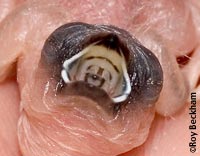 |
 |
||||||||||||
| Moluccan Mannikin - Lonchura molucca- - Except for the size of the chick being smaller than other Asian mannikins, you could easily confuse this chick with any other Asian Lonchura. Very similar mouth markings. | Java Sparrow - Padda oryzivora - A single horseshoe pattern with more of point at the top. Yellow palate too. | ||||||||||||
| Other Finches | |||||||||||||
 |
 |
||||||||||||
| Red Headed Finch - Amadina erythrocephala - Red Head and Cutthroats used to be classed with mannikins. Markings show this is incorrect. | Cutthroat Finch - Amadina fasciata - Very similar to the Red Headed. | ||||||||||||
